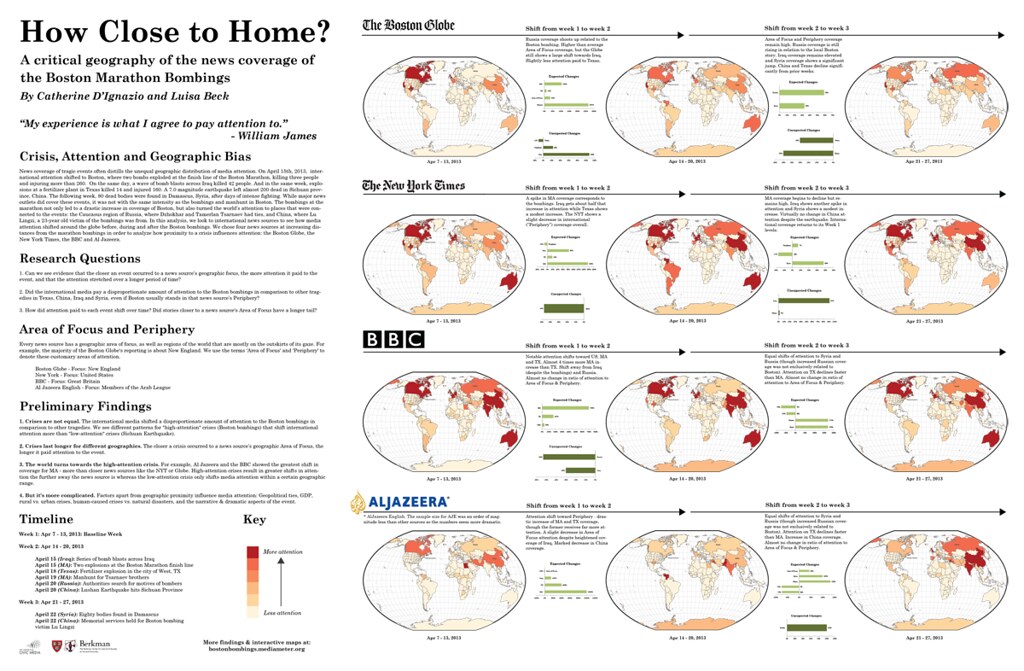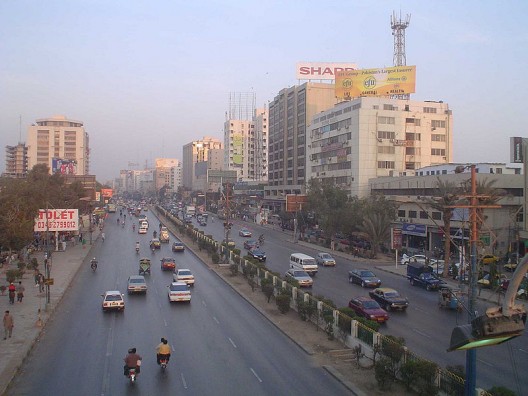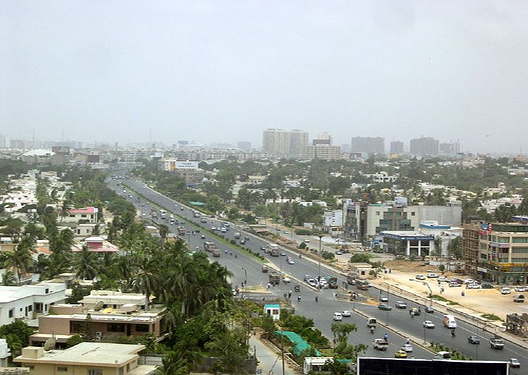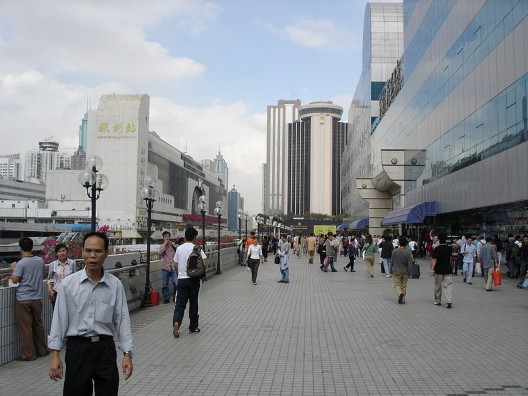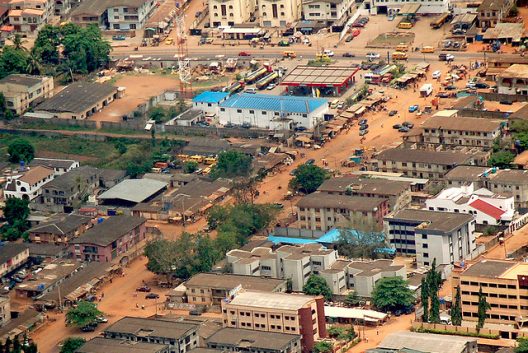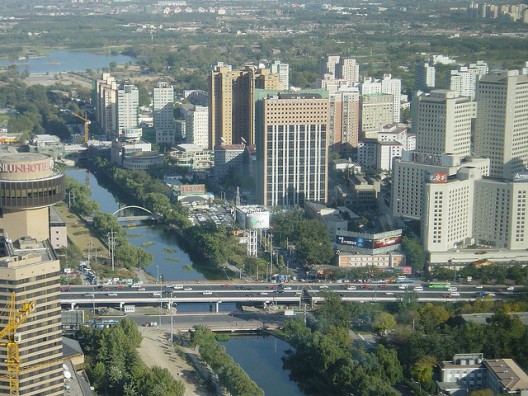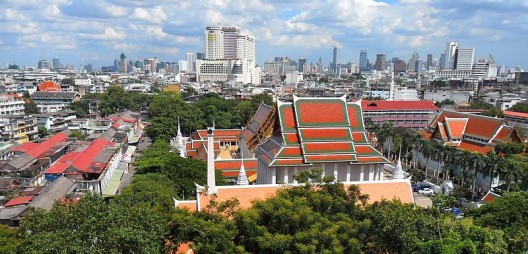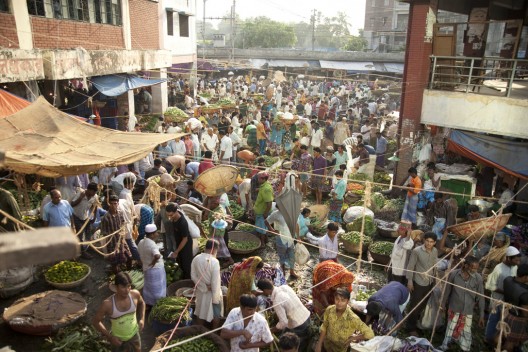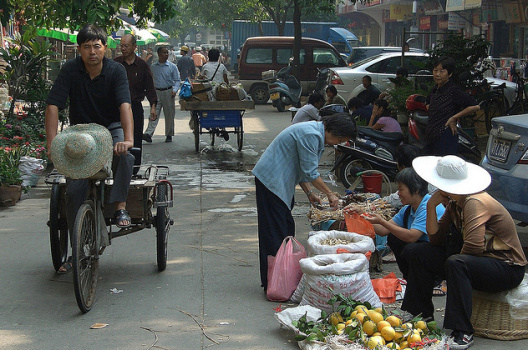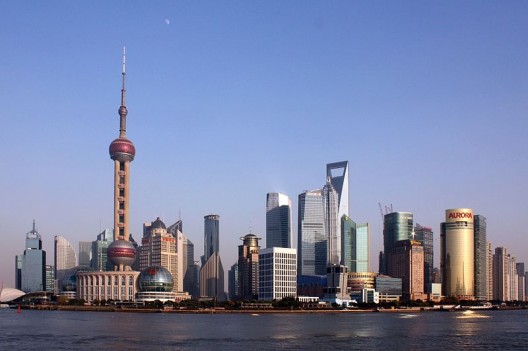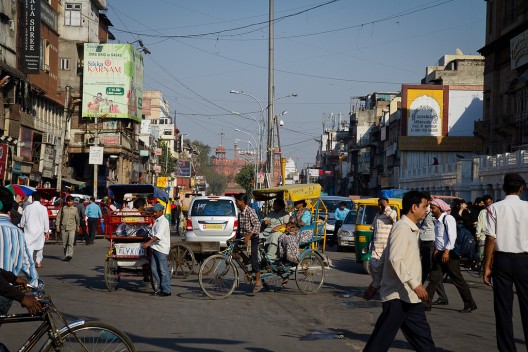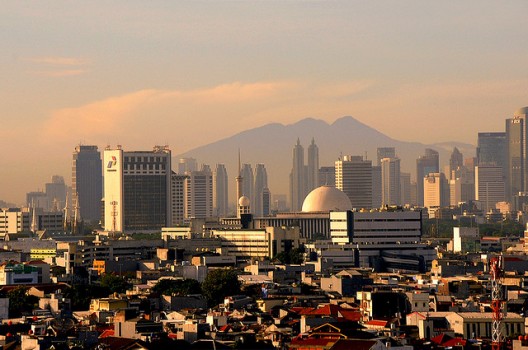Shared posts
1282864311-peeweeftw.jpg (JPEG Image, 349x298 pixels)
Complete Strangers Meet Up for Family Portraits
wskentI find this very entertaining. MAYBE YOU DO TOO?
You know those cheesy group family shots that your parents pull out anytime you introduce them to a new friend? You were probably wearing acid washed Osh Kosh B’Gosh overalls with a few teeth missing- right after that time you got a hold of scissors and cut your own hair, standing behind your mom, hands neatly folded on her shoulder pad. What if rather than uncomfortably posing with the people you’re closest to, your arms rested on the shoulders of a complete stranger? Creating that surreal experience is exactly what NYC based photographer Jamie Diamond did for a series called Constructed Family Portraits. Seeking out strangers in public and via Craigslist, the artist met people in hotel rooms to awkwardly compose the “picture perfect” holiday card that nobody would ever have.
See Also MODIFYING SOCIAL BEHAVIOR WITH WILD BENCHES
According to Diamond’s artist statement:
I am interested in the shifting paradigm of the traditional family structure and in the paradox of the familiar. The portraits are of actual people being themselves in an entirely new context; they intuitively follow the rules of the genre and the group they form for the camera ascribes them an identity. I am constantly questioning the past and present narrative, the still and moving image, and the space between authentic experience and artifice.
As much of a sociology project as a photography experience, Diamond’s results are as awkward as they are hilarious. Check out more photos from this and other series at JamieGDiamond.com.
Via: athenna.com
What's Curious about Curious City?
wskentNEWS!
 Hmmm. What's going on in Chicago? Jennifer Brandel's new concept for topsy-turvying standard news agenda setting in a major public media newsroom is about to spread.
Hmmm. What's going on in Chicago? Jennifer Brandel's new concept for topsy-turvying standard news agenda setting in a major public media newsroom is about to spread.
Read Knight's announcement http://kng.ht/14620ac *snip* the project offers an experimental Internet-based model for community-powered content creation online and on-air and empowers the public to suggest, vote on and participate in stories as they are reported *snip*
Brandel is one of the dozen lead producers AIR hired and dispatched to help build new innovation capacity at local public radio and television stations across the US, and carry public media into new corners of the local community. This spring, after a year of R&D, the projects are blossoming and we're seeing a new cohort of producer-entrepreneurs emerge from an exciting field of production (http://www.Localore.net). With the support of Knight, Curious City is, indeed, out front of its sister projects, moving to prototype the model. Others are expected to follow. About 50 public media news directors showed up recently at a webinar to satisfy ... well... their curiosity. You can go deeper into Brandel's thinking by checking it out at http://www.prndi.org/post/finding-funding-webinar-archive And, to get a better look at the ground level experience of our ten production teams, watch our 30-minute documentary @ http://bit.ly/ThisIsLocalore
c. 1970s : Johnny Cash eating a cake
wskentScoundrel!
Iowa City to ban red-light cameras, drones, and license plate readers too
wskentIowa = more progressive than you think. Always.

On Tuesday evening, Iowa City is scheduled to hold the first reading (PDF) of what is likely the first municipal bill anywhere in the country to simultaneously ban the local use of drones, license plate readers, and red-light cameras—three tools increasingly used by law enforcement and often fraught with privacy-related controversy.
The ordinance is the result of a local petition brought forward by a citizen group that originally began as a referendum on red light cameras. Iowa City is the only municipality in the state that allows for local petitions to turn into ordinances that will be brought before the city council. Some states have similar lawmaking procedures at the state-level, but Iowa does not.
As currently drafted, the bill reads:
Read 11 remaining paragraphs | Comments
Solar Socket: Portable Plug-In Creates Free Energy to Go
wskentCool.

With batteries running low, your eye roams the room for a place to plug in, but then you remember: you brought your own power supply – all you need now is a window. Portable, easy and green, this solar socket design is a stroke of genius, able to both generate and hold a charge.

A suction cup lets you stick the converter to any flat glazed surface, putting photovoltaic panels on the outside and a customary energy outlet on the other. And if you are worried about what happens at night or in overcast conditions: the device itself can store energy for in-place or mobile use.

Kyuho Song & Boa Oh have added a few other functional quirks to the design: rotate your charger plug and you kill the power, spinning a circular cut-off switch built into the face plate. There is a second manual on/off switch on the bottom as well.




[ By WebUrbanist in Gadgets & Geekery & Technology. ]
[ WebUrbanist | Archives | Galleries | Privacy | TOS ]
How Close to Home? Crisis, Attention and Geographic Bias
wskentWhoa, interesting.


Boston Marathon Bombings, April 15, 2013 Lushan Earthquake, April 20, 2013
(Credit: AFP/Getty Images, National Geographic)
A Critical Geography of the News Coverage of the Boston Marathon Bombings
By Catherine D'Ignazio and Luisa Beck
News coverage of tragic events often distills the unequal geographic distribution of media attention. On April 15th, 2013, international attention shifted to Boston, where two bombs exploded at the finish line of the Boston Marathon, killing three people and injuring more than 260. On the same day, a wave of bomb blasts across Iraq killed 42 people. And in the same week, explosions at a fertilizer plant in Texas killed 14 and injured 160. A 7.0 magnitude earthquake left almost 200 dead in Sichuan province, China. The following week, 80 dead bodies were found in Damascus, Syria, after days of intense fighting.
While major news outlets did cover these events, it was not with the same intensity as the bombs and manhunt in Boston. The bombings at the marathon not only led to a drastic increase in coverage of Boston, but also turned the world’s attention to places that were connected to the events: the Caucasus region of Russia, where Dzhokhar and Tamerlan Tsarnaev had ties, and China, where Lu Lingzi, a 23-year old victim of the bombings was from.
In this analysis, we look to international news sources to see how media attention shifted around the globe before, during and after the Boston bombings. We chose four news sources at increasing distances from the marathon bombings in order to analyze how proximity to a crisis influences attention: the Boston Globe, the New York Times, the BBC and Al Jazeera.
How Close to Home? Interactive Web Version
Research Questions
-
Can we see evidence that the closer an event occurred to a news source’s geographic focus, the more attention it paid to the event? And did that attention stretch over a longer period of time?
-
Did the international media pay a disproportionate amount of attention to the Boston bombings in comparison to other tragedies in Texas, Iraq and Syria, even if Boston usually stands in that news source’s periphery?
-
How did attention paid to each of these events shift over time? Did stories closer to a news source's focus have a longer tail?
Definition of Terms
Area of Focus / Periphery: Every news source has a geographic area of focus, as well as regions of the world that are mostly on the outskirts of its gaze. For example, the majority of the Boston Globe's reporting is about New England. We use the terms 'focus' and 'periphery' to denote these customary areas of attention.
|
News Source |
Area of Focus |
|
Boston Globe |
New England |
|
New York Times |
United States |
|
BBC |
Great Britain |
|
Al Jazeera English |
Members of the Arab League |
Expected/Unexpected: ‘Expected’ denotes the outcomes that we anticipated, based on our own intuitive understanding of the selected news sources and how they operate in the news ecosystem. ‘Unexpected’ refers to attention shift percentages that fall outside of these ‘expected’ trends.
High-attention crisis vs Low-attention crisis: What we characterize as high- versus low-attention crises denote the shift in media attention to that particular geography, not the overall quantity of reporting. For example, the events in Massachusetts and Texas both follow the pattern of a high attention crisis in that they shift international media attention towards them. The sources furthest away from the events - the BBC and Al Jazeera English - show the greatest shifts in attention. However, the overall amount of coverage for the Texas explosion was much lower than for the Boston bombings. The Lusan earthquake in China follows the pattern of a low-attention crisis because the notable shifts in media attention were from news sources more proximate to the event while far away sources like the New York Times and the Boston Globe either showed no shift or actually decreased their China coverage.
Methodology
Inputs: We used the MediaCloud API to retrieve a data set of about 20,000 news articles.
-
Four news sources at progressively further geographic distances from the events in Boston: the Boston Globe, the New York Times, the BBC, and Al Jazeera English.
-
Three weeks of news coverage - the week before the Boston bombings (April 7-13th), the week of the event (April 14th - 20th), and the week following (April 21st - 27th). We used the first week as our "baseline" to show what kind of geographic coverage each news source "normally" engaged in (though we address below how a more robust study would use a longer timeframe of data to develop its baseline).
Processing: Over the last several months we have been conducting research into geographic parsers that are capable of extracting geographic entities from unstructured text. The results of this study will be a separate blog post to come in the next couple weeks. Our results from this work showed that using CLAVIN as a base geoparser along with some custom algorithm development was able to yield up to 90% correct placement of news articles at the country level. We ran each news article through this system to determine the country and/or US state that article was most "about" and then, for each week, compiled a list of article numbers by geography.
How Close to Home? Poster PDF Version (28MB download)
Analysis
Our analysis focuses primarily on the shifts in media attention from week to week and only secondarily on the overall quantity of news stories. From these week by week numbers, we were able to calculate the shifts in media attention for the specific geographies we were interested in: MA, TX, Iraq, Syria, Russia, and China. These places were either related to the Boston bombings (MA, Russia, China) and/or were places where other tragic events had occurred during the same time period.
During the analysis, we devised the various categories defined above that helped us track media shifts: geographic Area of Focus/Periphery for each news source, expected vs. unexpected outcomes on a weekly basis, and high- vs low-attention crises. We looked for spatial patterns in the data based on geographic proximity.
Findings
1. Crises are not equal. The international media shifted a disproportionate amount of attention to the Boston bombings in comparison to other tragedies. We see different patterns for "high-attention" crises (Boston bombings) that shift international attention more than "low-attention" crises (Sichuan Earthquake).
2. Crises last longer for different geographies. The closer a crisis occurred to a news source’s geographic Area of Focus, the longer it paid attention to the event.
3. The world turns towards the high-attention crisis. For example, Al Jazeera and the BBC showed the greatest shift in coverage for MA - more than closer news sources like the NYT or Globe. High-attention crises result in greater shifts in attention the further away the news source is whereas the low-attention crisis only shifts media attention within a certain geographic range.
4. But it's more complicated. Factors apart from geographic proximity influence media attention: Geopolitical ties, GDP, rural vs. urban crises, human-caused crises vs. natural disasters, and the narrative & dramatic aspects of the event.
Caveats & Open Questions - "But it's more complicated than that"
-
No single factor explains news sources’ attention to a particular event or region of the globe. Communication scholars studying news values have found evidence that the media deems an event “newsworthy” based on a wide range of factors that include geographic proximity, country GDP, number of troops in a foreign country, story narrative structure and political interests, among many others (see also Galtung, 1965; Jones, Van Aelst, & Vliegenthart, 2011). In our project, heat maps allowed us to visualize attention and begin to hypothesize about the role that geographical proximity plays in channeling attention. But we realized quickly that “proximity” can mean different things. During the week of the Boston Marathon bombings, stories about Russia were, in a sense, local. They weren’t really about Russia, but a continuation of the Boston coverage that now turned to Chechnya and Dagestan to understand the Tsarnaev’s brothers’ motives. Our maps don’t account for this kind of “local” coverage.
-
We also didn’t select articles for topics, but looked at place mentions, which means that articles about a country or state could be about a topic unrelated to one of the six selected events.
-
A lack of attention shift can be deceptive. For example, we didn’t see a shift in China coverage for the New York Times between the second and third week. But that doesn't mean that the New York Times didn't cover the story. Rather, it replaced its “usual” China coverage (stories about the economy, environment, etc.) with earthquake coverage, and therefore we didn’t see an article count shift.
-
The sample size of our data for Al Jazeera English was an order of magnitude less than for other sources (150 per week versus approximately 2000 for other sources). Because of this, it’s difficult to draw conclusions about that particular news source. To verify our conclusions, we would need to incorporate a larger data set.
-
The same holds true for our baseline week. In our next steps, we want to expand our baseline data to encompass a longer timeframe so that we can establish a more comprehensive picture of how news sources "regularly" cover the globe.
-
We selected our ‘Area of Focus’ and ‘Periphery’ based on our intuitive understanding of the geographic areas that the selected news sources focus on. But it’s debatable whether the NYT is “international” or “international with a US focus” or whether the BBC is focused on the British Commonwealth or the UK, etc.
Links
- An interactive web version of the project, including all of the maps, graphs and descriptions can be found at: http://bostonbombings.mediameter.org/
- You can also download a PDF poster version of the project (28 MB download)
- Also check out our preliminary Map Handbook for Journalists
Celebrate Bike to Work Week, No Matter What You Weigh
wskentGrab your bike, get to it!

Image: Fitness for Weight Loss
[Due to Chicago's fickle spring weather, we celebrate Bike to Work Week a month later than most of the country. However, to get you excited for next month's events and about encouraging friends and family to try urban cycling, here are some interesting stats about the benefits of biking. - JG]
Happy Bike to Work Week, everybody! It’s a great time to give a gentle nudge to someone who you think would benefit from biking. In that vein, personal trainer and fitness coach Stephanie Averkamp of San Diego posted this infographic to her personal health website. She says she especially hopes to convince overweight and obese people to bike more.
“Biking’s a great exercise because it supports 50 to 70 percent of their body weight,” Averkamp told me. “It’s not like running. It’s something they can do without the extra weight and impact on their joints.” She said biking is a great way to get exercise outside of a gym, which can be intimidating and unpleasant.
She encourages people to start by biking halfway to work. “That counts!” she says.
Infographic after the jump.
HOWTO move an immensely delicate 50'-wide circular electromagnet
wskentI have several questions. But mostly, I'm just glad they're putting a ring on it.
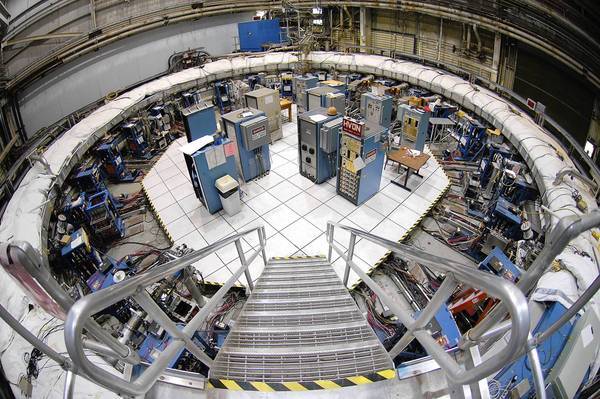
Fermilab just got a new Awesome Magnet, a 50'-wide jobbie that can't be tilted by more than a few degrees without suffering irreparable harm. It's in New York, though, and Fermilab is outside of Chicago, and this presents a logistical problem with a complicated solution:
The Muon g-2 ring, an electromagnet made of steel and aluminum, begins its 3,200-mile trek from New York in early June. From there, it will sail by barge down the East Coast, around Florida's tip into the Gulf of Mexico, then up the Mississippi River until it arrives in Illinois.
Once on land, the electromagnet will be driven at night in a specially designed truck at no more than 10 mph until it reaches Fermi National Accelerator Laboratory.
The high-tech transport is all in service of a plan to use Fermilab's powerful beam to send muons, a rare kind of particle that lasts just 2.2 millionths of a second, into the circular electromagnet, according to experiment spokesman Lee Roberts, who works at Fermilab. Once in the ring, muons "wobble," or tilt like a top.
Huge magnet set for delicate voyage to Fermilab [Alexa Aguilar/Chicago Tribune]
(via /.) ![]()
Ohio bans those dangerous dens of iniquity, Internet cafes
wskentThere we go, Ohio. Really paving the way.
Lawmakers in the Buckeye State have just banned Internet cafes, believing them to be nothing more than essentially unregulated corner casinos. As the Daily Dot notes, this move follows a ban that Florida passed in April, and several California municipalities are also getting on board with bans.
The cafes in Ohio mostly draw an older crowd, according to cafe owners. The cafes tried to get around casino regulations by saying they offered legal online "sweepstakes." There are only four legal casinos in Ohio, a state which authorized Las Vegas-style gambling just one year ago.
Cafe owners pled their case vigorously in the legislature, arguing that 6,000 jobs would be lost to the ban and that they should be regulated, not banned. It didn't help; the state Senate voted 27-6 to pass a ban. Ohio Governor John Kasich has said he'll sign the bill when it gets to his desk.
Read 3 remaining paragraphs | Comments
Ranking 2013: Las 10 megaciudades de más rápido crecimiento en el mundo
wskentOjo - keep an eye out for these places.
En 2050, siete de cada 10 personas vivirán en ciudades, según estimaciones de las Nacionales Unidas. Como ya es visible, la mayor parte de la población mundial se ha asentado en áreas urbanas, incidiendo en que ciertas regiones hayan protagonizado un crecimiento demográfico explosivo en los últimos años. Frente a esto, la consultora estadounidense Demographia determinó cuáles son las diez ciudades de más rápido crecimiento en los últimos años en donde habitan diez millones de personas o más.
Utilizando ocho fuentes entre las que destacan datos de censos nacionales, mediciones anteriores realizadas por las Naciones Unidas e imágenes satelitales que permiten estimar la población de ciertos lugares, Demographia midió el crecimiento de 875 ciudades con 500.000 habitantes o más, según su población, superficie y densidad de población.
Cabe mencionar que la gran mayoría de las diez ciudades que encabezan el listado se ubican en países en vías de desarrollo. Sin embargo, esto no quiere decir que en el futuro se convertirán en megaciudades, entendiéndolas como zonas urbanas con más de 10 millones de habitantes.
A continuación encontrarás el ranking.
Diez ciudades de más rápido crecimiento en el mundo.
1. Karachi, Pakistán.
Acogiendo exactamente 20 millones 877 mil habitantes, según Demographia, ésta ciudad asiática aumentó su población desde su independencia del Reino Unido en 1947. Tras esto, logró posicionarse como un nuevo polo industrial y económico para el país. Tal fue la atracción que esto generó en los habitantes de ciudades vecinas que su población protagonizó un crecimiento de un 80,5% en los últimos diez años, por lo que el gobierno ha debido planificar nuevas obras de ingeniería que ayuden a mejorar la calidad de vida de sus habitantes. Una de las más representativas es el tren Karachi Circular Railway que consiste en reactivar una antigua línea férrea que data de 1964 y que dejó de funcionar en 1999. Con esta, 38 kilómetros quedarían conectados con el tren en una fecha indeterminada porque la Unidad de Transporte Urbano de Karachi propone que estaría listo en 2017, mientras que la Agencia de Cooperación Internacional Japonesa, que financiaría parte del proyecto, propone que recién en 2022 funcionaría.
2. Shenzhen, China.
Reconocida en 1980 como una “zona económica especial” en donde es posible desarrollar un sistema económico de libre mercado, su atractivo provocó que un gran número de empresas se instalaran en la ciudad. Ante esto, Shenzhen pasó de ser una caleta de pescadores a otro lugar más diverso marcado por un auge económico. A pesar de ser una de las dos ciudades con menor número de habitantes dentro de las diez que encabezan el listado (sobre los 12 millones), Shenzhen ha experimentado un crecimiento de la población en un 56,1% sólo en la última década.
3. Lagos, Nigeria.
El crecimiento demográfico urbano que ha tenido lugar en África se ha concentrado mayoritariamente en Lagos, el principal centro económico del país y uno de los más importantes del continente. Su protagonismo se vio fortalecido por la instalación de grandes transnacionales ligadas al petróleo que generaron que una gran parte de la población rural migrara a la ciudad en busca de mejores oportunidades. Hoy en día, en Lagos habitan 12 millones 90 mil personas, lo que significa que en los últimos diez años la ciudad creció un 48,2%.
4. Beijing, China.
El crecimiento económico sostenido y los bajos índices de desempleo han desembocado en que cada año alrededor de 600.000 personas se trasladen a la ciudad. Con este panorama, se han generado problemas externos, como contaminación, congestión vial como consecuencia del aumento del parque automotriz y una limitación de recursos. Por esto, su alcalde, Wang Anshun, declaró que “haremos esfuerzos para controlar la escala de Beijing a través de medios económicos, legales y administrativos”. Además agregó que “la ciudad no puede expandirse de manera descontrolada”.
5. Bangkok, Tailandia.
Un informe del Banco Asiático de Desarrollo (BAD) consigna que ante el aumento de la población en la capital tailandesa, es necesario crear estrategias de desarrollo sostenible, para enfrentar la contaminación que existe en la ciudad. Además, esta iniciativa se debe concretar puesto que en los próximos diez años 21 de las 37 ciudades más pobladas del mundo estarán en Asia. A pesar que la ciudad se ubica en la costa y que por lo mismo se han generado inundaciones, el peligro latente parece no desencantar a los habitantes que cada año se instalan en el lugar.
6. Daca, Bangladesh.
A pesar que Daca es una ciudad con altos índices de delincuencia y pobreza, contaminación y congestión, los habitantes de las zonas rurales se trasladan hasta allí para encontrar trabajo en una de las tantas fábricas textiles. La proliferación de éstas industrias sumado a una barata mano de obra, le han valido a Daca el reconocimiento internacional como el segundo exportador textil a nivel mundial, tras China. No obstante, esta industria ha sido duramente cuestionada por las condiciones laborales y la falta de seguridad que deben soportar los trabajadores.
7. Cantón y Foshan, China.
Ubicadas al sudoeste del país y separadas entre sí por sólo 20 kilómetros, éstas ciudades sirvieron como alternativa a las empresas inversionistas extranjeras que consideraron que Hong Kong elevó los precios de su mano de obra. Asimismo, como el gobierno chino impulsó en 1990 una serie de reformas tributarias, Cantón y Foshan no sólo vieron su desarrollo económico, sino que vivieron un claro aumento de su población que, según los datos de Demographia, alcanza los 17 millones 681 mil habitantes. Ésta última cifra es reflejo del crecimiento de un 43% que se dio en la última década.
8. Shangai, China.
En los años ’50, se llevó a cabo un plan de descentralización que consistió en que Shangai incluyera en su trama urbana varios pueblos satélites y que las viviendas de los trabajadores se ubicaran a un costado de los lugares de trabajo. Con esta última medida, la población se trasladó a Shangai, superando las expectativas de los especialistas y produciendo una alta densidad poblacional en el centro de la ciudad. Actualmente, en esta cosmopolita ciudad de china viven más de 21 millones de personas que evidencian que sólo en los últimos diez años la población de la ciudad creció en un 40%.
9. Delhi, India.
Los primeros indicios de crecimiento urbano explosivo en Delhi se remontan a 1947 cuando el país se independizó del Reino Unido. Luego de este episodio, las migraciones aumentaron notoriamente y terminaron sumir a los indios a condiciones de hacinamiento. Según los resultados de Demographia, en Delhi habitan 22 millones 826 mil personas que han llevado a la ciudad a protagonizar un crecimiento demográfico de un 39,2%.
10. Yakarta, Indonesia.
La contaminación y un deficiente sistema de transportes público son elementos cotidianos con los que deben lidiar los 26 millones 746 mil habitantes que residen en Yakarta y que en la última década representaron un crecimiento demográfico de un 34,6%. Si a esto sumamos que entre diciembre y febrero la ciudad debe enfrentar inundaciones producto de un crecimiento urbano desmedido, se obtiene que el aumento de la población no fue contenido ni bien dirigido. En palabras de Hongjoo Hahm, especialista en infraestructuras del Banco Mundial (BM) en Indonesia, “si no se pone remedio (a las inundaciones), un tercio de la ciudad estará bajo el agua en 2050, una catástrofe que afectará a millones de personas”. Esta declaración tiene directa relación con el boom económico de la ciudad que llevó a las autoridades a impulsar grandes obras de ingeniería, como autopistas, centros comerciales y viviendas que obstruyen las vías naturales de desagüe de los ríos.
Ante los resultados obtenidos, una de las sorpresas del ranking es la ausencia de ciudades estadounidenses y europeas entre las de mayor crecimiento, lo que se contradice con algunas de las expectativas de la consultora.
A partir de los datos obtenidos, New Geography concluye que “el crecimiento más rápido se lleva a cabo en los países que aún cuentan con grandes zonas rurales interiores y con poblaciones relativamente jóvenes. Estos lugares mayormente pobres -por ejemplo en Daca y Bangkok- continuarán creciendo por lo menos hasta que sus poblaciones comienzan a ver los resultados de la disminución de las tasas de natalidad “.
Por su parte, el Instituto Global McKinsey, a través de su aplicación “Urbano Mundial” que examina cómo los niveles de población y otros factores van a cambiar en las ciudades en 2025, 440 grandes ciudades de las estudiadas representan la mitad del crecimiento económico del planeta para la misma fecha.
El informe completo de Demographia se puede descargar desde este link.
Estambul: La gran protesta generada por salvar el último parque público de la ciudad
La destrucción de un parque, más bien la destrucción del último gran parque del centro de Estambul fue lo que generó que en este minuto miles personas estén protestando en esa ciudad y también en otras ciudades de Turquía.
El gobierno Turco decidió que el Parque Gezi – ubicado junto a la plaza Taksim, una de las principales plazas de Estambul- sería reemplazado por un nuevo mall. Esto hizo que el día antes de que las maquinas llegaran al lugar un pequeño grupo de personas, decidiera ocupar el parque para evitar que éste fuera destruido.
¿Qué pasaría si quisieran demoler el Central Park o el Hide Park para construir un mall? Eso es lo que está pasando aquí! Se leía en el cartel que levantaba uno de los manifestantes.
Poco a poco miles de ciudadanos empezaron a salir a la calle y la protesta se ha convertido en un gran movimiento, donde los enfrentamientos entre los ciudadanos y la policía llevan varios días, transformando el parque y la plaza Taksim en un campo de batalla, con cientos de heridos y algunos ciudadanos muertos.
Lo ocurrido con el Parque Gezi, es la gota que rebalsó el vaso. La protesta se ha convertido en un movimiento masivo hacia el autoritarismo del gobierno, en esta megaciudad con 15 millones de habitantes, donde los ciudadanos han comenzado a exigir participar en los procesos de toma de decisiones sobre la ciudad en la que viven.
Otros proyectos urbanos como un nuevo puente sobre el bósforo, procesos de gentrificación en distintas zonas de Estambul – que han desplazado a sus habitantes para dar paso a departamentos y tiendas de lujo – y la construcción de varios centros comerciales en el último tiempo, estarían transformando la ciudad sin el consentimiento de sus ciudadanos.
El movimiento ha comenzado a extenderse a otras ciudades de Turquía, entre ellas a su capital Ankara. Los ciudadanos reclaman otras decenas de medidas autoritarias que han atentado en el último tiempo contra la libertad de expresión y el derecho a reunirse legalmente en cualquier parte de la ciudad, entre otros derechos fundamentales que no han sido respetados por el gobierno.











Is life on Earth older than the Earth itself?
wskentMIND BENDING
A pair of scientists looked at the rate at which the complexity of life increases and then extrapolated back to a point of zero complexity, aka the origin of life. The answer they came up with is 9.7 ± 2.5 billion years ago. Which is much older than the Earth. This idea has some provocative implications:
Tags: Earth scienceSharov and Gordon say their interpretation also explains the Fermi paradox, which raises the question that if the universe is filled with intelligent life, why can't we see evidence of it.
However, if life takes 10 billion years to evolve to the level of complexity associated with humans, then we may be among the first, if not the first, intelligent civilisation in our galaxy. And this is the reason why when we gaze into space, we do not yet see signs of other intelligent species.
Future Tense: Neal Stephenson and Tim Wu talk future, sf and tech
wskentInnanet for the innanet.

Slate, the New America Foundation and Arizona State University have kicked off a new podcast called "Future Tense," hosted by Internet scholar Tim Wu. The inaugural episode is an interview with Neal Stephenson wherein Neal and Tim talk about where the future has gone -- why we no longer seem to dream of jetpacks and instead focus on fiddly mobile phones. Stephenson gets some very good points in on the lack of predictivity in science fiction, and what sf really contributes to the future.
There are six installments in all -- coming episodes include conversations with Margaret Atwood and me!
Stranger Than Fiction, Neal Stephenson Edition
(Thanks, Tim!)
(Image: Neal Stephenson Answers Questions, a Creative Commons Attribution Share-Alike (2.0) image from jmpk's photostream) ![]()
    
|
The Most Jaw-Dropping Game Graphics of the Last 20 Years
wskentPerspective.
Debunking the HTML5 DRM myths
wskent"3.) the Web doesn't need big media; big media needs the Web." Yes. Yes, it does.

Kyre sez, "The Free Culture Foundation has posted a thorough response to the most common and misinformed defenses of the W3C's Extended Media Extensions (EME) proposal to inject DRM into HTML5. They join the EFF and FSF in a call to send a strong message to the W3C that DRM in HTML5 undermines the W3C's self-stated mission to make the benefits of the Web 'available to all people, whatever their hardware, software, network infrastructure, native language, culture, geographical location, or physical or mental ability.' The FCF counters the three most common myths by unpacking some quotes which explain that 1.) DRM is not about protecting copyright. That is a straw man. DRM is about limiting the functionality of devices and selling features back in the form of services. 2.) DRM in HTML5 doesn't obsolete proprietary, platform-specific browser plug-ins; it encourages them. 3.) the Web doesn't need big media; big media needs the Web. There is also a new coalition of 27 internet freedom companies and groups standing up to the W3C."
Don’t let the myths fool you: the W3C’s plan for DRM in HTML5 is a betrayal to all Web users. ![]()
    
|
Guía Urbana de Chile: Oficina Salitrera Santiago Humberstone
wskentMy-OH-my, what a pretty place!
A pocos kilómetros de Iquique en medio del desierto, una cerca de madera separa la abandonada Oficina Salitrera “Santiago Humberstone” de la carretera. Al llegar una calle de tierra, antiguos postes de luz, carretas inmóviles y casas que en su interior exhibenantiguos juguetes, telegramas yutensilios, entre otras cosas,dan unasilenciosa bienvenida a quienes llegan a conocer uno de los pueblos salitreros abandonados mejor conservados del mundo.Un viaje a esta zona solo puede estar motivado por algo que genere un gran interés y, sin duda, este Patrimonio de la Humanidad es capaz de entregar una experiencia única a sus visitantes.
Si lo que antiguamente daba vida a este trozo de desierto eran los trabajadores, empresarios extranjeros, mujeres y niños; lo que hoy día reina en el lugar es el viento y los chirridos que provoca al mover las puertas, ventanas y faroles desvencijados. Sin embargo, recorrer Humberstone no es solo adentrarse en una soledad que inunda todos los rincones, sino que también revivir lo que fue una de las mayores hazañas del hombre: el haber habitado el desierto más árido del planeta y extraer de él este mineral que alguna vezfue tan apreciado alrededordel mundo.
Como muchas otras, la historia del Salitre en el corazón de la pampa tuvo un inicio y un final abrupto, que muchos años después es posible descubrir caminando por las calles de Humberstone.
Historia
En 1872, once años antes de la Guerra del Pacífico concluyera con Perú traspasando a Chilelos poblados de Tacna, Arica y Tarapacá, La Palma-como fue llamada en un principio esta oficina salitrera-abría sus puertas gracias a la PeruvianNitrateCompany. La fama de ser de las únicas en el mundo junto a Santa Laura que extraía el nitrato natural a escala industrial recorrió rápidamente el mundo.
En el periodo de la Guerra del Pacífico, distintas empresas se hicieron cargo de la Oficina, hasta que en 1890, siendo propiedad de The New Tamarugal Nitrate Co. , se adapta el sistema Shanks para la extracción del salitre. Este hecho además de cambiar de forma significativa la extracción industrial de este mineral, es el responsable de que la oficina cambiara su nombre a Santiago Humberstone.
Cuenta la historia, que tras la Gran Depresión de 1929 la salitrera cerró sus puertas por algunos años, reanudando sus faenas en 1934, año en que en manos de la Compañía Salitrera de Tarapacá y Antofagasta, COSATANfue rebautizada en honor a Thomas James Humberstone, un ingeniero químico inglés de sólo 25 años, responsable de adaptar el nuevo sistema de extracción del salitre, pero quien además fue un hombre destacado por su trato humano y amable por lo que los trabajadores loreconocían llamándole cariñosamente “Don Santiago”.
Después de esto vendrían los tiempos de gloria para las ventas del llamado “oro blanco”, pero no pasó mucho tiempo hasta que el salitre sintético fue inventado.Así, casi de la noche a la mañana y sin remedio, el salitre chileno dejaba de ser competitivo en el mundo. Su época había terminado y con ella, la particular vida y cultura que por casi 90 años poblaron la pampa.
En 1961 se realizó en la gran piscina pública de la salitrera la reunión de despedida. Al final de la ceremonia se puso de forma simbólica un candado en la entrada del pueblo, cerrando oficialmente la actividad deHumberstone. Tiempo después fue subastada, pasando a ser propiedad de un particular. Sin embargo, en 1970 la Oficina Salitrera Santiago Humberstone fue declarada Monumento Nacional. Ya en 2002,pasó a ser propiedad de la Corporación Museo del Salitre, luego de ser adquiriera en un remate. Dicha organización es la que hasta hoy se hace cargo de lo que quedó de la salitrera. Finalmente, en el año 2005, la UNESCO nombróa HumberstonePatrimonio de la Humanidad.

Fábrica
Caminar por Humberstone
Para recorrerlo completamente se necesitan tres horas. Tres horas que valen la pena, porque al conocer su teatro, su hotel, la fábrica o las casas donde vivían los trabajadores se puede llegar a comprender mucho mejor la especial vida de las cerca de 3.700 personas que llegaron a habitar este lugar de la Pampa del Tamarugal. Lo que se vivió en esos tiempos hoyqueda escrito como dos historias contrastadas: una, la de fiestas en la cantina, eventos sociales en el teatro y compras en el mercado. La otra, aquella vida obligada a un clima extremo, sacrificada e indigna, y que provocó el descontento social que, de una y otra manera,culminó conla gran matanza de la Escuela Santa María de Iquique en 1907.
Al entrar, lo primero que se recomienda es pedir un mapa para planificar el recorrido, aunque una opción es acordarpreviamente una visita guiada con alguna agencia turística en Iquique. Sin embargo, si se quiere improvisar caminando por las calles, los lugares importantes están muy bien señalizados, e incluso en algunos casos, recreados tal como eran en la época dorada de Humberstone.
Aunque algunos sólo la miran de lejos, la fábrica, que se distingue por su gran chimenea, sin duda vale desafiar los miedos que provoca el pueblo fantasma. No sólo porque al recorrer la bodega, o la sala de maquinas es posible entender los procesos que allí se vivían, sino también porque entre sus galpones se puede disfrutar del paisaje y de la sensación de estar en un lugar que el tiempo se ha encargado de embellecer de una forma extraña.

Sala de Máquinas
Al bajar de la fábrica, está la casa de la administración, la cual queda junto a la cancha de tenis. En esta casona construida en 1883, hay una exposición que cuenta la historia del salitre y los años de gloria de su venta en el mundo.Además, su arquitectura recuerda el hecho de que las grandes salitreras del norte estaban administradas en su mayoría por una colonia inglesa que llegó hasta Chile a extraer el salitre que se encontraba en grandes cantidades en el desierto de Atacama.

Teatro
Luego se puede seguir hasta la plaza. Algunos imperdibles en sus alrededores sonla gran piscina olímpica, con su estructura de metal, sus trampolines y su gradería de madera; el hotel, donde se hospedaban algunos invitados y trabajadores extranjeros y donde además se encuentra la cantina; el teatro muy bien conservado, la pulpería en donde los trabajadores usaban las fichas con las que se les pagaba el trabajo las cuales sólo podían ser usadas dentro de la Oficina; el mercado; y la capilla. También se pueden recorrer las casas que dividían a los trabajadores casados de los solteros y el escalofriante hospital.Otros lugares fascinantes sonla casa del dentista, donde se puede ver cómo vivían quienes tenían más privilegios, y la escuela que aún conserva sus pupitres dentro de las salas de clases.

Piscina
Las calles de Humberstone además de contar la historia de los trabajadores del salitre, son testigo de la planificación urbana desarrollada en la fase tardía de la revolución industrial, lo que las convierte en un lugar de una gran importancia histórica tanto para Chile como para el mundo.

Pulpería
La Oficina Salitrera Santiago Humberstone es el testimonio de una historia no tan lejana, por lo que en ciudades cercanas como Iquique aún hay personas que alguna vez ocuparon las salas de clases de su escuela o fueron a misa en su capilla. Como una forma de recordar a quienes ahí vivieron y la cultura que se generó en torno a la industria del salitre una vez al añoHumberstone alberga la llamada “Fiesta del Pampino”.
No puede dejar de ver: en las casas de trabajadores en la entrada del pueblo, una exposición con cartas y telegramas de la época donde se relatan detalles de la vida y los problemas sociales que se vivían en Humberstone.
Ubicación: La oficina Salitrera Humberstone se encuentra a 47km al este de Iquique y a 7 Km al norte de la localidad de Pozo Almonte, en la intersección de la ruta A-16 con la ruta 5 norte.
Horario: de 9:00 a 19:00 todos los días del año, a excepción del día 1º de enero que se encuentra cerrada.
Entrada: $1.000 para adultos y $500 para menores de 18 años y adultos mayores de 60 años.































We Love Friday!- Hadouken Craze
wskentoh my, awesome
Remember planking and owling? Those memes are long gone. The newest craze is Hadoukening! The photo fad started in Japan and has quickly spread throughout the world. Based on the smooth battle moves of Ken, Ryu, & Sakura in the Street Fighters game, Hadoukening involves sending opponents flying through the air with a surge of spirit energy! We searched Instagram to bring you some of our favorite Hadouken-ers! Try it yourself this weekend because like most trends, the hype will not last long!
See Also ROCKIN’ REDDITS- PERFECT TIMING
Thank you so much to all of our wonderful Instagrammers! If you like a picture, be sure to click on the link and let them know. Next week’s theme will be food art, so throw out all the rules your mom taught you and play with your food! Snap a shot of your edible creation, upload it to Instagram, and tag it #foodart and @visualnews. The best ones will be featured next Friday. We would like to wish each one of you a relaxing Spring weekend! Thanks for reading.
Above: @columnfive Below: @severus_snapshot
Great dad dies (also, he was a scientist)
wskentClever, frustrating, clever.
 |
 |
How Much Driving Is Avoided When Someone Rides a Bike?
If Jane Doe rides her bike a mile to the post office and then back home, is it fair to assume she just avoided two miles of driving? And can we then assume that she prevented 2.2 pounds of carbon dioxide from being emitted?

Photo: Bike Reviews
That’s more or less the way most agencies calculate averted vehicle-miles traveled. One mile biked is one mile not driven.
That simple assumption masks enormous complexity, however. And with at least 33 states and hundreds of cities, towns, and counties having instituted climate action plans or emissions reduction targets, we’re going to need a better method of measuring the carbon that biking keeps out of the atmosphere.
It’s not too hard to figure out the carbon savings from reduced VMT. But looking at it the other way around — calculating the carbon-reduction benefits of increased biking — can be a challenge.
If bicycling is on the rise in your city — because of bike-share or better infrastructure, for example — what does that mean for your city’s carbon footprint? A mode shift metric that accurately captures this information could encourage municipalities to invest more in biking and walking as a carbon reduction strategy.
Not that biking always replaces driving. Some bicycle trips are primarily recreational and wouldn’t be made by any other mode. Or if someone shifts from bus commuting to bike commuting, then they’re obviously not taking a car off the highway (though the newly available space on the bus might then be filled by someone making the switch from driving to transit). Ten million U.S. households don’t have access to a car, according to the Brookings Institution, and regular cyclists are probably over-represented in that number. Shouldn’t it change the equation if a cyclists’ backup mode is transit or walking?
But there are also reasons to think that the 1:1 ratio is actually undercounting vehicle miles averted, and therefore underestimating the power of mode shift.
Blunt Instruments Overlook the Nuances of Transportation and Land Use
The Federal Highway Administration acknowledges some complexity in this problem but its tools are still remarkably blunt. The agency borrowed the San Francisco Bay Area’s measure of how many car trips will be replaced with bike trips if a new bike facility is installed. The assumption is that 1.09 percent of car trips on a project corridor will shift to bike trips. That number is then simply multiplied by the average length of a bicycle trip to calculate VMT averted.
For its Nonmotorized Transportation Pilot Program, FHWA estimated the additional trips that were taken by foot or by bike as a result of improvements and multiplied that by the average length of a non-motorized trip, according to the National Household Travey Survey: 2.26 miles for a one-way bicycling trip and 0.7 miles for a one-way walking trip.
But FHWA also points out that there may not be a “one-to-one mileage trade-off between vehicle trips and nonmotorized trips; it is likely that vehicle trips are often longer than walking and bicycling trips, particularly for discretionary utilitarian trips (like shopping or dining out).”
FHWA’s guidance also notes that the reduction in miles driven could be longer than the actual bicycle or pedestrian trip if those trips are linked with transit. Strategic installation of biking and walking facilities near transit can have an enormous multiplier effect. But to measure it, you need to figure out how many people wouldn’t have taken transit without the walkway or bikeway and how many of them would have driven alone all the way to their destination instead.
A Los Angeles Metro survey indicated that 27 percent of people who linked bicycle and transit trips would have taken a car the whole way if there were no bicycle connection to the transit station. Metro didn’t distinguish between those who would drive alone, carpool, or get dropped off.
Sometimes Destination Follows Mode Choice, Not the Other Way Around
Models assume that a person decides on their destination and then picks their mode of travel. But sometimes the mode choice influences the destination.
If I’m on foot, I’m often going to go to the organic grocery store four blocks away, but it’s expensive. If I have access to a car, I might decide to go to a supermarket that’s farther away, but cheaper, and stock up on essentials.
Different trip patterns on different modes can complicate the attempt to quantify how much driving is avoided when someone bikes. Studies have shown that cyclists, on average, make more shopping trips than drivers, probably because they buy only what they can carry home. Portland State University researchers found that people who drove visited a convenience story an average of 9.9 times per month, while biking customers visited the same store 14.5 times a month.
Land use and social preferences are also key factors. There are community characteristics that won’t change with the installation of a new sidewalk or bike lane.
“You can take a suburban community and put in better bike facilities, and let’s add some closer destinations — infill stuff, so people have stores nearby – but you’re dealing with the population who still lives there,” said Robert Schneider, professor of urban planning at the University of Wisconsin-Milwaukee. “And those people moved there because they have certain preferences and might not realize the new opportunities that are there.”
All of these factors would make for some complicated modeling, to be sure. But it’s not impossible.
How the Experts Do It
Brian Gregor is a transportation analyst at Oregon DOT. He was instrumental in developing GreenSTEP, a tool that lets ODOT estimate and forecast the effects of various policies on the amount of vehicle travel, the types of vehicles and fuels used, energy consumption, and the resulting GHG emissions. GreenSTEP was used as a model for FHWA’s Energy and Emissions Reduction Policy Analysis Tool (EERPAT).
“You’ve got to have a certain amount of simplification,” he told Streetsblog. But for GreenSTEP, Gregor didn’t shy away from complexity. “You’ve got the vehicles and their different power trains,” he told me, “the different vehicle mixes; you’ve got the fuels, and then you’ve got the myriad of things that affect VMT, which include transit service levels and prices, and all the characteristics of the household, and interactions between those factors.”
To measure carbon emissions averted, Gregor doesn’t just use fuel economy averages. He looks at schedules of average fleet MPG by model year, all the way out to the year Oregon’s greenhouse gas emission goals are aiming toward, accounting for the full variety of vehicle body type and power train. Also in the mix is each fuel, including electricity, with its particular carbon intensity.
His team also factors in, at the household level, the number of people of different ages, their incomes, the land use type (urban or rural), the density of neighborhood, whether it’s a mixed-use neighborhood, the existence of transit service, and other factors — and from there, they determine the household’s likelihood of owning a vehicle, how many vehicles, the likely ages of vehicles, and their likely VMT.
That’s how they estimate carbon emissions — first at the household level and then at the state level. Could they have just multiplied the number of cars registered in the state by average VMT by average fuel economy by pounds of CO2 per gallon? Sure. But they wouldn’t have gotten very good data. Is it so preposterous to think someone might use this degree of precision to understand the carbon-reducing power of non-motorized transportation?
Gregor says he’s never tried to deduce miles not driven or carbon emissions avoided from biking and walking numbers. But he says it could be done. “That’s where urban travel demand modeling is moving,” he said. “These things are getting more sophisticated.”
March 1924 : Hippo cart
wskentMay this be popular somewhere, somehow.
Sartorial zoo animals
wskentLook good.
Yago Partal pictures animals dressed up in their finest duds. Some of these are better than others...this is one of my favorites:

Prints are available.
Tags: art Yago PartalArchitecture from the Fantastic World of the Future
If you live in almost any city around the world for very long, you’re bound to see a new skyscraper fill the skyline, slowly rising to impressive heights by the methodical assembly of cranes perched on its peak. Architectural firms are now so adept at creating these massive structures that even complex examples like London’s new Shard can seem to spring up overnight, surprising you one day as you round a familiar corner and glance skyward. In a way, our modern world isn’t that far from the towering worlds we have here, imagined by the Belgian master of comic art, François Schuiten.
See Also This Just In: The Future is Illustrated and Retro
Raised by a family of architects – his mother, father and one sibling – it was inevitable that buildings would feature heavily in his works. Drawing comics since the mid 70s, his love for the built world first made itself known in his 1983 series Les Cités Obscures (Cities of the Fantastic in english). In it, fantastic structures dominated many sweeping illustrations, often blending architectural elements into a landscape that refused to follow strict rules of scale. In each of the series’ stories, architects and urbanists were the leading powers and the driving forces behind society.
Always one to blend elements of the past and future, art and science, it was only appropriate that Schuiten illustrate an edition of Jules Verne’s rediscovered book, Paris in the Twentieth Century. And, with such inspired design flowing throughout his work, it makes sense that it would cross over into the real world; seeing him create the artwork for the metro station of Porte de Hal in Brussels and the entire Jules Verne-esque interior design for the Arts et Métiers metro in Paris. Learn more about François Schuiten and his broad catalogue of work on Wikipedia, or find many of his books for sale on Amazon.











Below, three chapter pages from Les Cités Obscures


Via Tumblr










